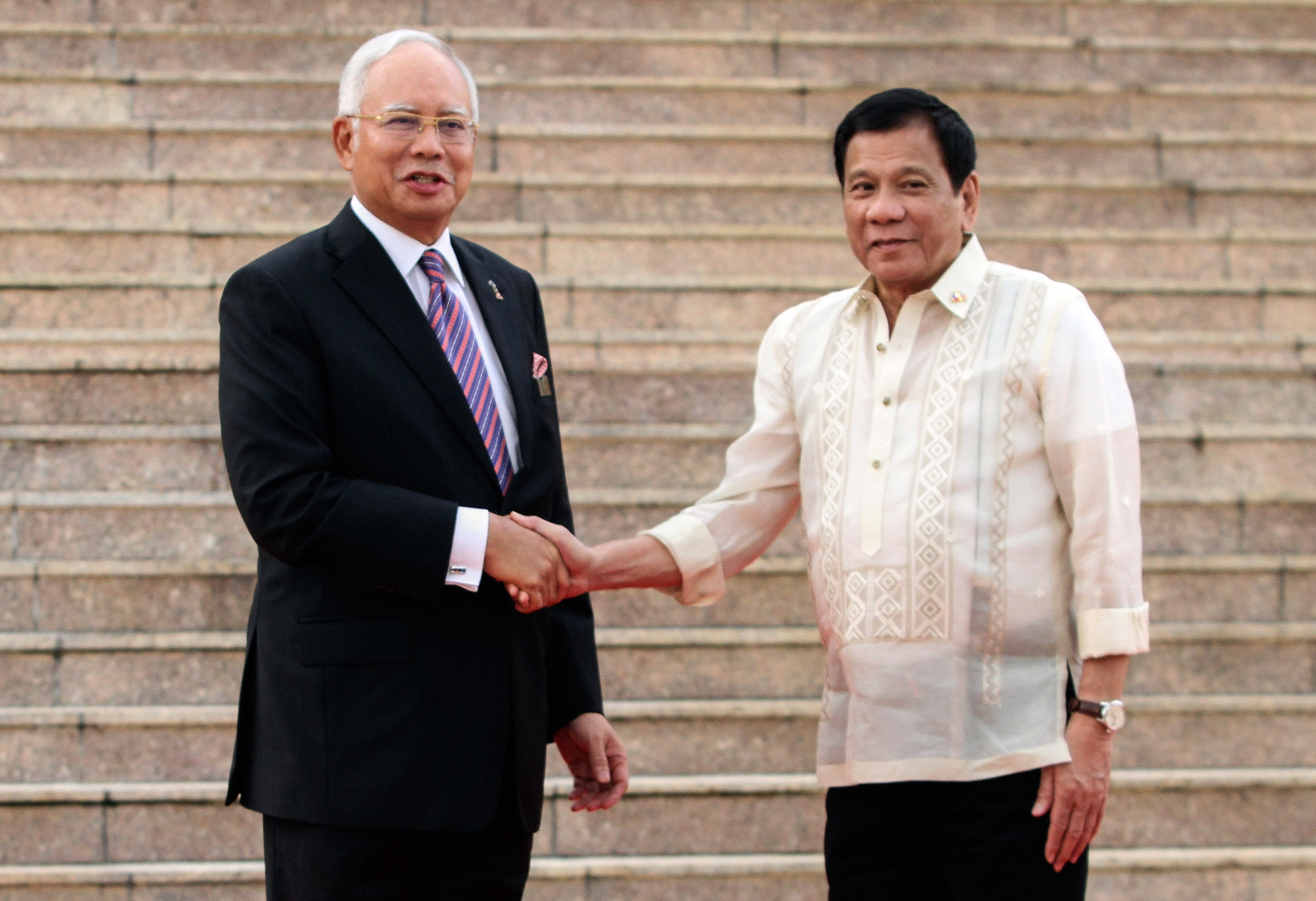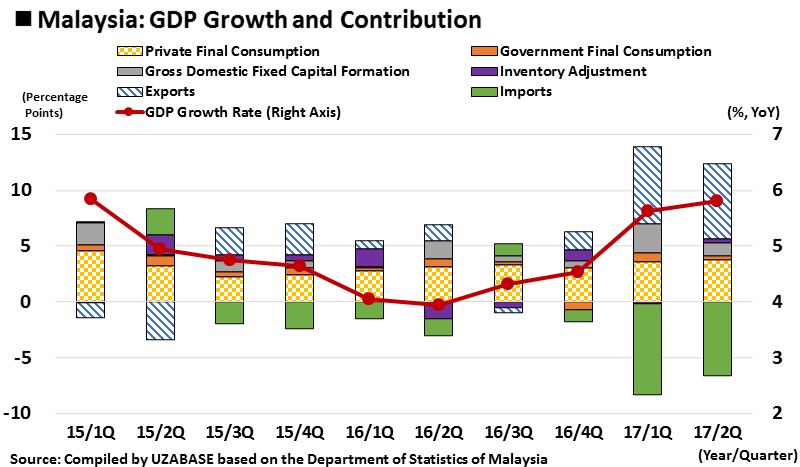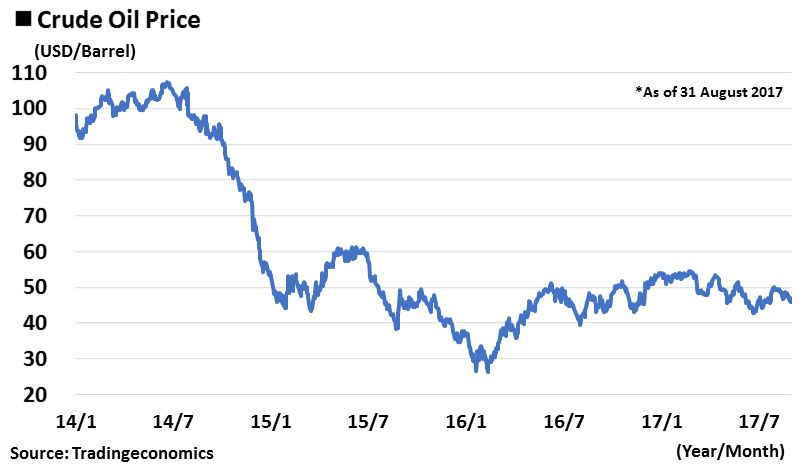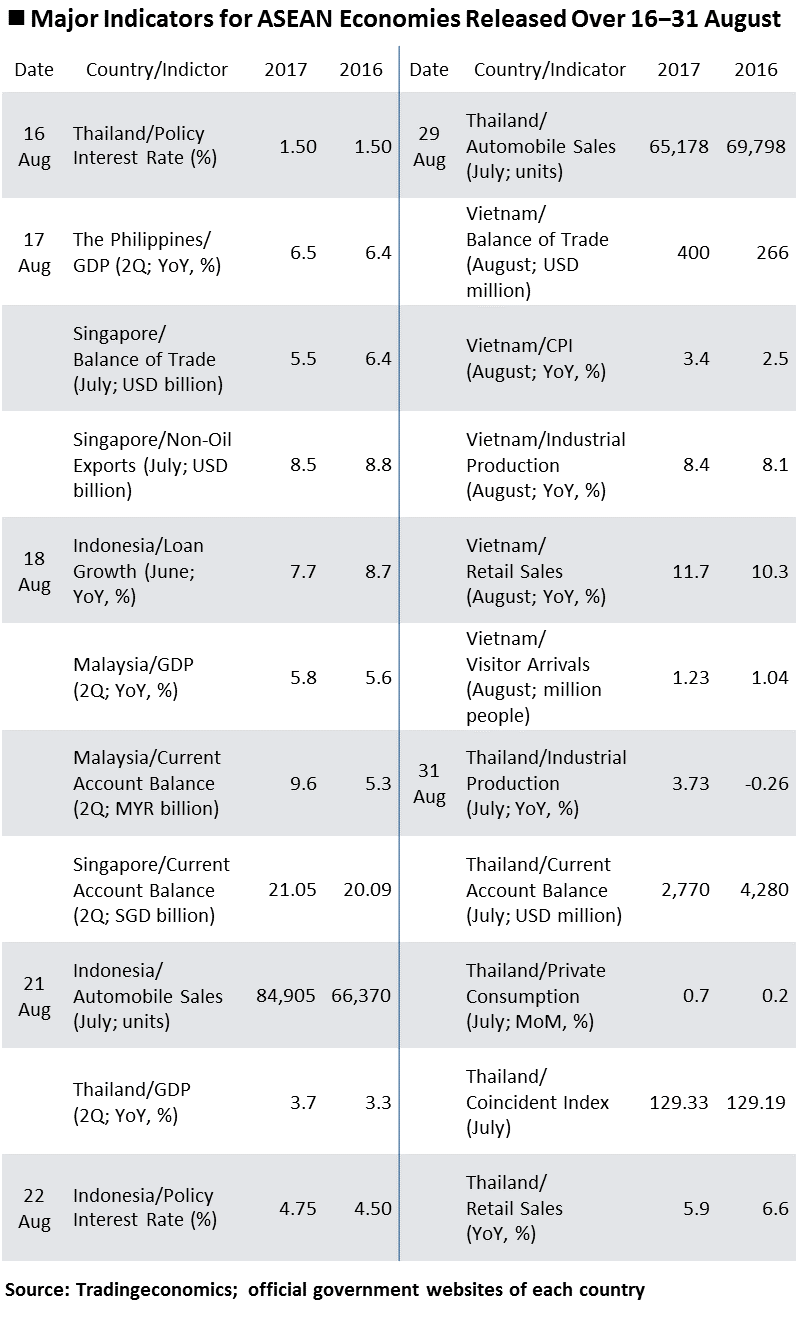ASEAN Macroeconomic Trends: Malaysia and the Philippines Undergoing Rapid Growth; Indonesia Lowered Interest Rate
|
Of the critical macroeconomic indicators released for the ASEAN economies from 16–31 August, Thailand, Malaysia, and the Philippines announced their real economic growth rates (GDP growth rates) for 2Q 2017. The central banks of Indonesia and Thailand also held monetary policy meetings. This report will focus on and look into the indices and economic policies of Indonesia, Thailand, Malaysia, and the Philippines, as well as the stirring political trends concerning the former Thai Prime Minister Yingluck Shinawatra. |
|
Indonesia: Lowered Interest Rates for the First Time in Ten Months On 22 August, Bank Indonesia (BI) held the Board of Governor’s Meeting and decided to lower the policy interest rate by 25 basis points (bps) to 4.50% from 4.75%. In line with this, the lending facility rate was reduced to 5.25% from 5.50%, and the deposit facility rate to 3.75% from 4.00%. 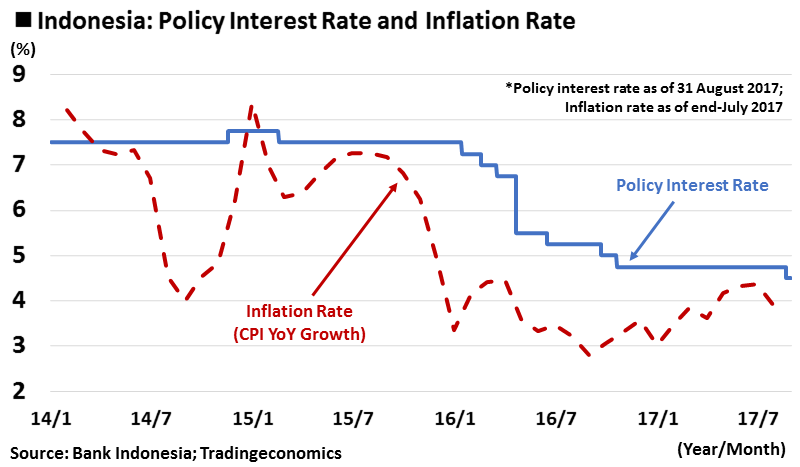 Amidst the grounds for BI’s interest rate cut are the sluggish inflation over 2017–18 and the slow progress in the US interest rate hike, which led the country’s interest rate to remain attractive for investors. Furthermore, the central bank claims that the domestic and international market risks are limited, and will continue to observe the US interest rate hike trends. BI maintained its previous projections for inflation rate, with the 2017 and 2018 levels standing at 4.0% and 3.5%, respectively, within a ±1% variation. In addition, BI acknowledged that the 5.0% YoY GDP growth for 2Q was slightly lower than expected; this, coupled with the stable exchange rates for the Indonesian rupiah and the better-than-expected current account deficit to GDP ratio (below 3%), drove the central bank to launch the interest rate cut to stimulate market sentiment. July’s automobile sales recovered to a normal level of 84,905 units in Indonesia, compared to a significant fall to 66,370 units in June due to weak consumption after the Lebaran holiday. 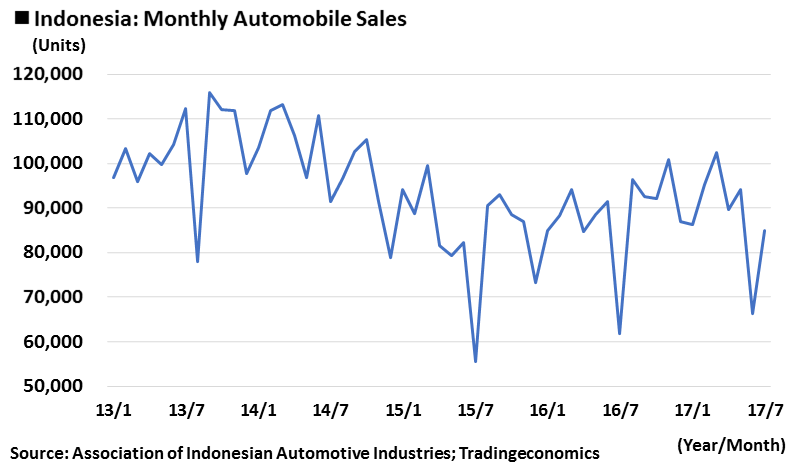 Cumulative automobile sales rose 4.1% YoY to 618,630 units in 2017 (January–July) from 595,020 units in 2016. However, automobile sales will likely level off or report slow growth towards the end of the year as the peak season for consumption during Ramadan has passed. (Note: In Indonesia, there is a legally mandated salary bonus for all employees that is paid upon the entry of Ramadan, which is a month of fasting in the Islamic calendar. The bonus is for travelling home and dining and gifting with families and friends during the Lebaran holiday, which marks the end of Ramadan fasting, and usually boosts private consumption, for example, for new car purchases. Therefore, consumption tends to decline after the holiday.) |
|
Thailand: Maintained Policy Interest Rate Amidst Gradual Economic Growth The Bank of Thailand (BOT) decided to maintain the current 1.50% policy interest rate at the Monetary Policy Committee Meeting on 16 August. The BOT claimed that both exports and domestic demand for products and services are steady, and despite a lack of strong momentum, the country’s economic growth is on a gradual recovery with the inflation rate calming down, so the current policy interest rate is appropriate. Thailand’s 2Q YoY GDP growth rate was 3.7% as per the government’s release on 21 August, accelerating from the 3.3% in 1Q. The expedited growth in 1H is largely attributable to exports and the gradual recovery in private consumption. 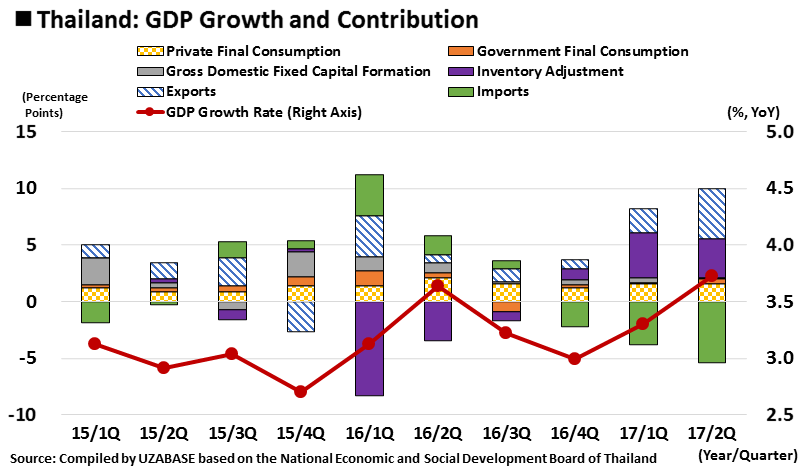 In light of this, the National Economic and Social Development Board (NESDB) of Thailand revised its estimated full-year GDP growth rate upwards to 3.5–4.0% from 3.3–3.8%. Although the current favourable trends are expected to continue, further attention is required as the economic slowdown in China, the appreciation of the Thai baht, and the damage to the agricultural sector caused by the flooding, amongst other factors, may depress the market in future. There are also political moves that are worth attention. Thailand’s former Prime Minister Yingluck Shinawatra was accused of negligence over the rice-pledging scheme under her administration during 2011–14, where the government purchases rice from farmers who pledge rice at an allegedly, overly high price, causing financial damage to the state. Yingluck fled Thailand the day after the former Thai Minister of Commerce was convicted and sentenced to 42 years in prison on 25 August, as reported by local papers. The Supreme Court of Thailand postponed the trial to 27 September and issued an arrest warrant for Yingluck, but it is nearly impossible to arrest her outside the country. It is believed that the former Prime Minister Thaksin Shinawatra, who is also Yingluck’s brother and fled abroad, offered help.  Ousted former Thai prime minister Yingluck Shinawatra greets supporters as she leaves the Supreme Court in Bangkok, Thailand, August 1, 2017. REUTERS/Aukkarapon Niyomyat Former Thai Prime Minister Yingluck Shinawatra at the Supreme Court on 1 August, warmly welcomed and encouraged by her supporters, showing deeply-rooted popularity amongst the people even after being ousted. Photo by Reuters/Aflo The next Thai general election is scheduled for 2018, and the power is projected to move to a civil government from the current ruling military junta. The incident involving Prime Minister Yingluck Shinawatra occurred amidst a tumultuous political environment, where the red-shirts and the yellow-shirts are wrestling with each other and a third-party power might eventually emerge. It is believed that the Thailand’s political landscape will become increasingly uncertain going forward. |
|
Malaysia: Rapid Economic Growth Nearing 6% Malaysia released its 2Q YoY GDP growth rate on 18 August, with the figure edging up to 5.8% from the 5.6% in 1Q. The country’s inflation rate also remained at around 3%, recording 3.2% YoY. Steady private consumption and rapid expansion in exports in both 1Q and 2Q drove the country’s economic growth, with the export value of semiconductor-related products and primary products on the rise. Based on these trends, Muhammad bin Ibrahim, the governor of the Central Bank of Malaysia (Bank Negara Malaysia, BNM), ascertained that the country will very likely achieve, or even exceed, the estimated full-year GDP growth rate of 4.8% in 2017. Although the implementation of the Goods and Services Tax (GST) in April 2015 temporarily weakened private consumption, its adverse effect seems to have worn off as of now judging from the country’s GDP growth. In addition, although the crude oil price plunged from the second half of 2014 and hit the country’s exports severely, the price recovered to USD 45–50 per barrel from mid-2016, and the exports of primary products such as crude oil, natural gas, and palm oil recovered thereafter. That said, a nearly 6% real economic growth rate for an economy like Malaysia indicates the market is slightly overheated, as were the market conditions in 2014. However, as the country will likely be forced to increase its interest rate eventually along with the US interest rate hike, it is believed that the central bank and the government will continue to push policies aiming for rapid economic growth for now rather than interfering with the market. Moreover, as the next election is approaching for the Malaysian House of Representatives (the Dewan Rakyat), there are also speculations that the ruling party might call a snap election amidst the favourable economic trends. 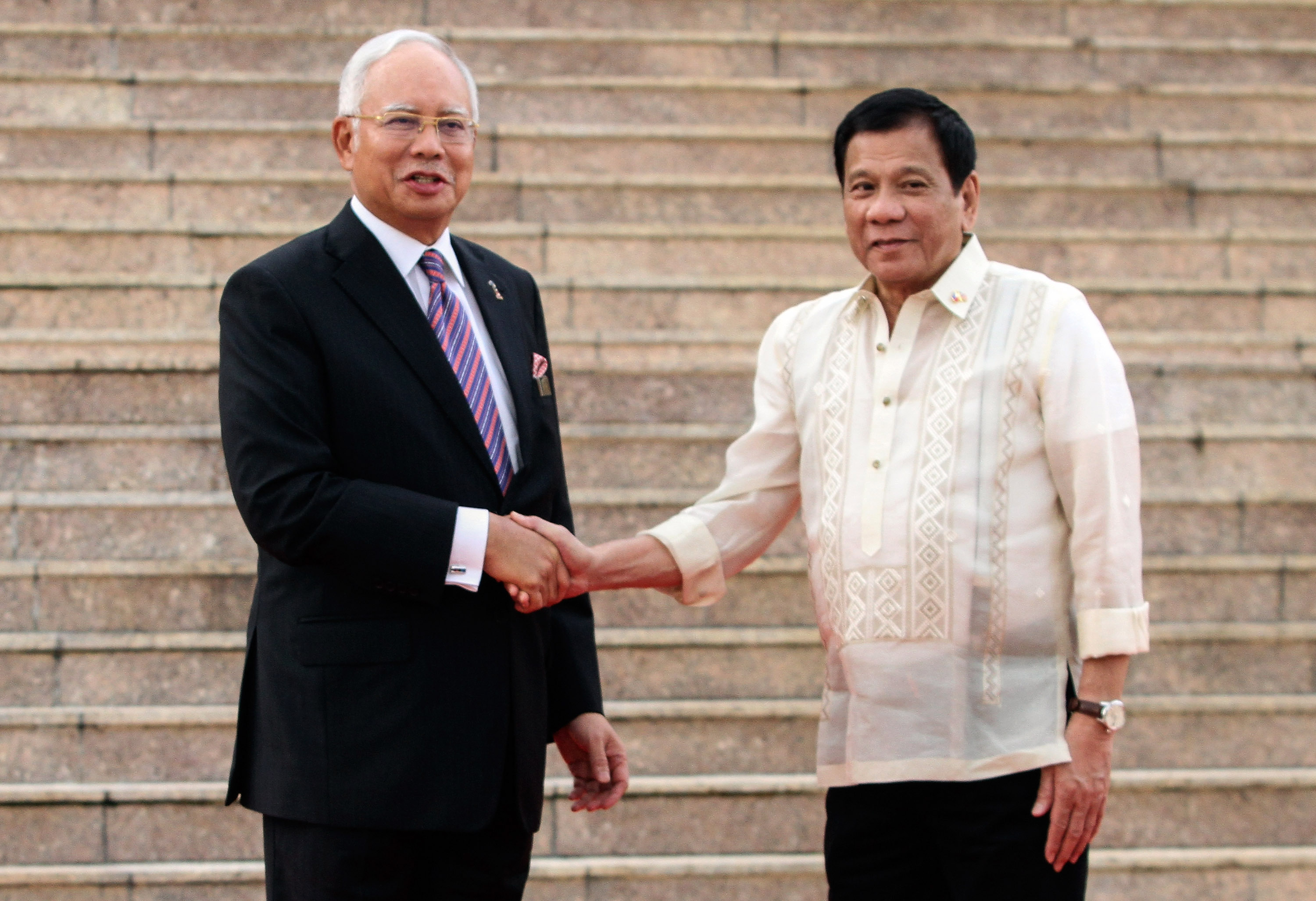 KUALA LUMPUR, MALAYSIA – NOVEMBER 10: Malaysian Prime Minister Najib Razak shakes hand with Philippine President Rodrigo Duterte at the Prime Minister’s office during an official visit on November 10, 2016 in Kuala Lumpur, Malaysia. Rodrigo Duterte is on a two-day working visit to Malaysia. (Photo by Mohd Samsul Mohd Said/Getty Images) Malaysian Prime Minister Najib Razak (left) shaking hands with the President of the Philippines Rodrigo Duterte (right), both leading their countries to achieve rapid economic growth. Photo by Mohd Samsul Mohd Said/Getty Images |
|
The Philippines: 2Q Economic Growth Remained Strong The Philippines’ 2Q GDP growth rate stood at 6.5% on a year-on-year basis, levelling off from the 6.4% in 1Q and maintaining strong momentum. Although the country’s economic growth over the period of 4Q 2015–4Q 2016 was fuelled by gross domestic fixed capital formation (investments), from 1Q 2017 onwards, exports have exhibited a substantial increase and underpinned the rapid economic growth. The favourable export growth is attributable to expanding demand from the IT sector globally and the resultant, rising exports in the semiconductor market. Private consumption, on the other hand, is somewhat sluggish at present, but stable overall, thereby contributing to the GDP growth. 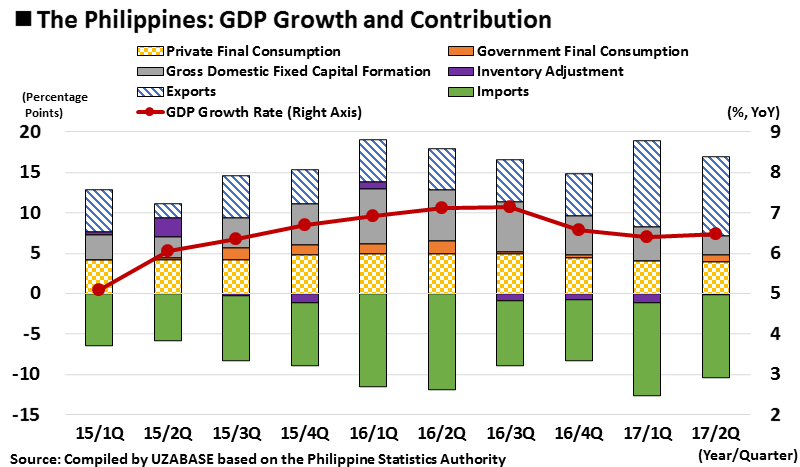 In light of these trends, Ernesto Pernia, the Director-General of the National Economic and Development Authority (NEDA), says the Philippines will likely hit the government-stipulated full-year GDP growth projection of 6.5–7.5% in 2017. Going forward, the Duterte administration’s flagship policy of strengthening the country’s infrastructure is expected to drive growth in private consumption. It should be noted that private consumption will likely remain stable due to the special economic structure where OFW (Overseas Filipino Workers) cash remittances account for around 10% of the Philippines’ nominal GDP in foreign currency, which form the basis for private consumption. Therefore, investments and exports are what ultimately affect the country’s long-term economic growth. In other words, promotive policies that concern the external environment, such as those aimed at vitalising domestic industries and luring foreign capital, are the keys to further economic development. |
|
Summary and Key Focus in the Next Report Amongst the ASEAN nations that have released their 2Q economic growth rates, Malaysia maintained high growth at 5.8% YoY, Thailand continued to retain gradual yet accelerating growth at 3.7% YoY, and the Philippines posted the highest figure at 6.4% YoY despite levelling off from 1Q. Each country is influenced favourably by increasing exports thanks to the rising demand in the IT sector globally. The central bank of Indonesia pushed an interest rate cut for the first time in ten months by 25 bps. Although it is unlikely that the market sentiment will be instantly boosted by such a marginal reduction, this precautious measure is believed to derive long-term economic prosperity, as the country tends to implement financial and monetary policies that monitor and adjust the market environment over an extended period due to its massiveness and diversity. |
|
The next report will cover the period from 1–15 September and focus on the following indicators in particular (dates in the brackets are scheduled release dates). Indonesia: Inflation Rate (August; 4 September), CCI (August; 7 September), Retail Sales (July; 11 September), Balance of Trade (August; 15 September) Thailand: Inflation Rate (August; 1 September), CCI (August; 4 September) Malaysia: The Monetary Policy Statement (7 September) Singapore: Unemployment Rate (2Q; 15 September), Retail Sales (July; 15 September) |
|
|
